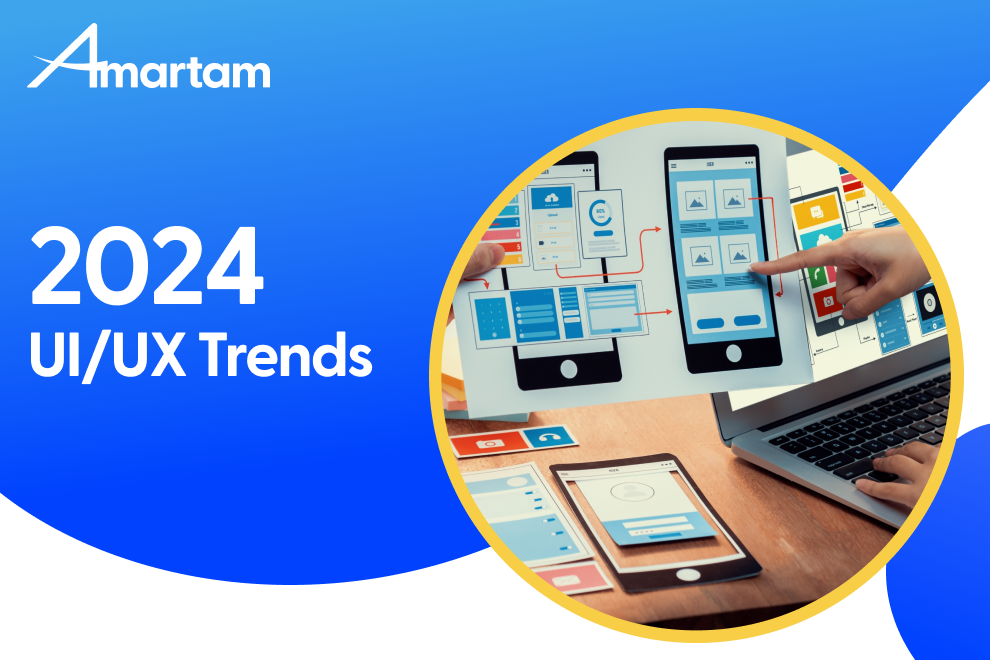
The importance of UX design and development in providing compelling digital experiences is growing. UI/UX development services are changing in 2024 due to new technologies, customer expectations, and ethics. This thorough essay covers 2024’s top UI/UX development services trends and how designers can use them to create engaging, intuitive, and appealing digital experiences.
UI-UX demand
Future UI/UX services will certainly be in high demand. Several factors will increase demand for user interface and user experience expertise.
Advancements in Technology
Digital interactions increasingly incorporate augmented and virtual reality, AI, and voice user interfaces. Professionals with expertise in user interface design and user experience will be in great demand
Mobile/App Development
Mobile apps are essential for content and digital marketing services. UI/UX designers are essential in the fast-growing mobile app development business for creating responsive, user-friendly, and beautiful mobile interfaces.
Constant Change
Change is constant in the user interface and user experience sector. Businesses rely on designers who can easily adjust to shifting consumer tastes and technological norms if they want to stay competitive. It is imperative that UI/UX specialists continuously enhance their expertise.
Here are 2024’s top 10 UI UX trends:
UI responsive
In spite of its advanced years, responsive UI design remains the bedrock of top-notch user interface and experience design. Designers with experience in user experience and interface will make it a priority in the year 2024. With so many devices in users’ hands, it’s crucial that websites and apps provide a uniform experience regardless of the user’s screen resolution or size. Ensuring that users can simply switch devices without compromising design is crucial.
Virtual and Augmented Reality
Augmented and virtual reality will change user interface and experience design in 2024. Immersive settings make augmented and virtual reality products more engaging and participatory. From VR game interfaces to AR retail experiences, designers must think outside the box to create interesting and user-focused products for immersive environments.
Micro-interactions
Micro-interactions in user interface and user experience design can affect user mood. The best designers of 2024 will focus on building micro-interactions that delight users, help them complete tasks, and provide quick feedback. These minor nuances can affect consumer satisfaction. Micro-interactions that are more advanced are the unsung heroes of user interface design because of their subtle yet strong character. From the year 2024 onward, these will be more than just a visual joy. Each contact provides context-specific responses, so guiding and satisfying users concurrently. Designers are incorporating them as crucial components in user engagement techniques, which are becoming increasingly popular. Consider features such as progress bars that animate not just to display the current state but also to provide feedback on the speed at which the user is entering information, or icons that, in reaction to the activities of the user, change their shape or color. Digital platforms become more user-friendly and less difficult to understand for new users as a result of these interactions.
Voice-UI
Voice user interfaces have been gaining traction for a while now, and their significance will continue to soar in the year 2024. People are becoming accustomed to speaking to their phones and other electronics due to the proliferation of smart speakers and other voice-activated devices. Skilled designers are necessary for naturally conversational and user-friendly user interfaces (VUIs).
3D Modeling and Simplistic Style
Because of the complexity and interaction that 3D design features bring to digital interfaces, their adoption will keep on rising in 2024. Interfaces that combine 3D design with minimalism principles are both aesthetically pleasing and easy to use. Engaging user interactions are made possible by combining depth and simplicity, which also helps to keep the design aesthetic clean and uncomplicated.
Integration of AI
In 2024, AI will greatly affect UI/UX design and development services. AI tools can analyze user information as well as behavior to inform design decisions. AI will help designers create adaptive user interfaces and personalized content suggestions.
Night Mode
In 2024, dark mode will still be a common design choice for OLED screens since it reduces eye strain and saves battery life. Websites and desktop programs are also embracing dark mode settings, expanding this trend beyond mobile apps. Dark mode is a crucial feature that experienced designers should think about adding to improve accessibility and user preference.
Environmental friendliness
Environmental concerns will make sustainability a key factor in user interface and experience design in 2024. Designers seek eco-friendly solutions by promoting ethical design, reducing carbon footprints, and optimizing energy use. Anyone concerned with social and environmental issues will like sustainable design, which benefits the environment.
Easy Accessibility
An essential tenet of user-centered design, accessibility is more than a passing fad. There will be a marked increase in the priority that designers give to making user interfaces accessible to people with impairments in the year 2024. To guarantee accessibility in user interface and experience design, elements like screen readers, keyboard navigation, and high-contrast modes must be included.
Personalization
The year 2024 will see the continuation of the trend toward personalization in user interface and experience design. Users anticipate personalized experiences that address their individual tastes and requirements. Expert designers will combine data and AI to create user-centric interfaces, content, and suggestions that boost engagement and happiness.
The future of user interface aesthetics is glassmorphism.
The translucent, frosted-glass effect that characterizes this style provides a sleek and contemporary appearance that is suited to both mobile and desktop interfaces thanks to its versatility. An emergent characteristic of the user interface design of the future is glassmorphism. Twenty-four years from now, this pattern will undergo fresh modifications, particularly with regard to compatibility across several platforms. Glassmorphism is a technique that incorporates blurred backdrops with sharp, clear data points to generate a focus on vital information without overwhelming the user. Designers are exploring novel methods to utilize glassmorphism in data presentation.
Conclusion
New technology, user-centered design, and digital innovation will impact UI/UX design and development services in 2024. To create attractive, intuitive, and technologically advanced user interfaces, skilled designers must stay current. The UI/UX development services environment will be defined by responsive UI, augmented reality, and sustainability next year, ensuring superior digital experiences. Designers who want to make it big in this industry should follow these UX/UI trends so they can create amazing user interfaces and experiences that cater to today’s users’ evolving needs.
